In this log we will give an introduction into muscle stimulation and about our Electrical stimulationbased haptic setup. We will also look at our haptic system in action in a short video.
What is transcutaneous electrical nerve stimulation and how does it work?
Electrical stimulation (E-Stim) refers to the application of electrical current to muscles or nerves in order to achieve functional and therapeutic goals. It has been extensively used in various clinical settings. Electrical muscle stimulation (EMS) is the process of providing electrical impulses using a signal generator to cause muscles to contract. using electrodes The muscles naturally contract in response to electrical signals from the EMS impulse similar to how they would contract some an input from the brain. EMS devices have been used in physiotherapy and rehab medicine since the 1960s to regenerate lost motor functions. EMS is now used in fitness training, wellness applications, medical applications, and even in HCI design applications. The other primary electrotherapy systems like Transcutaneous electrical nerve stimulation (TENS) uses a very similar setup to instead stimulate nerve endings to provide pain relief. TENS units primarily provide pain relief by exciting sensory nerves and thereby stimulating either the pain gate mechanism and/or the opioid system. TENS as a treatment technique is non invasive and has few side effects when compared with drug therapy.
The TENS machine will deliver discrete ‘pulses’ of electrical energy, at a pulse rate or frequency that may be varied from about 1 or 2 Hz up to 200Hz. To be clinically effective, it is suggested that the TENS machine should cover a range from about 2 – 150Hz. The other important factor for TENS units is pulse width or the duration for each pulsation. Intensity of the pulsation too is another important key factor for TENS units.
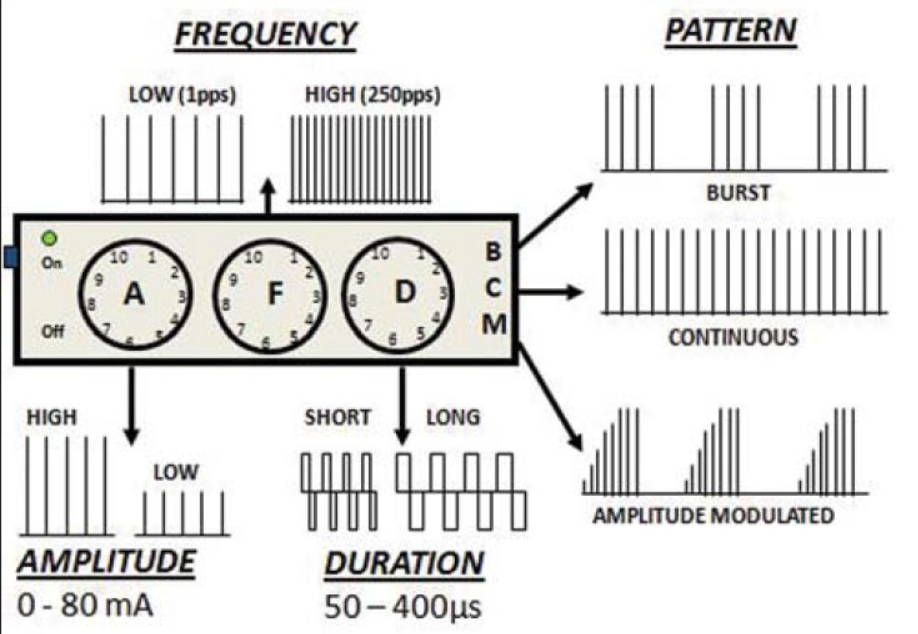
Consumer TENS devices typically have presets modes wherein they have different combinations of pulse intensity, time duration and frequency. By carefully managing the profile of the TENS unit's stimulation we can provide both muscle and nerve stimulation.
Note on safety:
A key point to note at this juncture is that we aim to provide electro stimulation for the muscle bundles and proximate nerves and not Neruostimulation (Neurostimulation is still in early research stage and requires extensive supervision by experts). To ensure safety of the user we decided early in our design against generating our own TENS pulsations. We instead chose the approach of modulating the output of a FDA certified TENS unit instead using safe switching.
Reference works and must read work:
Much of our work in electrostimulation devices was inspired by the amazing work by
Max Pfeiffer's amazing work with EMS based haptic feedback and Pedro Lopes's work with the OpenEMSStim. Their solutions involve a similar setup of using a clinical TENS/EMS as a source for pulsations and switching it on and off with a digital switch (Relay/MOSFET). The inspiration for linking breathing and TENS came from a study conducted by Dr. Shen Li wherein he designed a system to deliver a pulsed electrical stimulus to a target area when voluntary inspiration reaches the threshold. His system, BreEStim integrates intrinsic physiological interactions which get activated during voluntary breathing, his method has shown stellar results and increased patient compliance. Further we were inspired by studies using TENS for alleviating mental stress through soothing stimulations.
Before we start, it is crucial to follow every instruction provided by Pedro's Do's and Dont's. This was a principal guide for the design of this section of our project. Now with that out of the way, let's look at the core elements of controlling TENS output suggested by the above researchers.
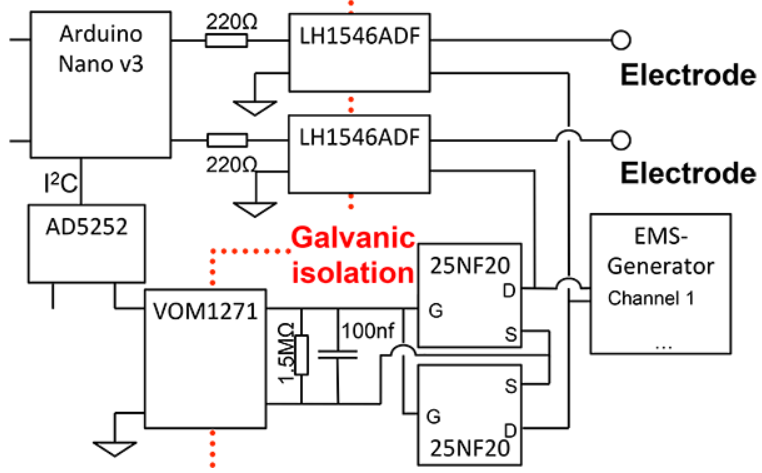
The above schematic shows the cruicial elements of Max's system, He first provides galvanic isolation between the EMS modulation circuitry and the other electronics including the MCU and power through use of Optoisolators. He then uses the isolated gate pulses to drive two 25NF20 N channel MOSFETS to control the intensity of the EMS/TENS pulsation delivered to the electrodes. Two MOSFETS are essential since almost all EMS/TENS units use biphasic pulses to prevent electrolyte deposition and the allergic reaction associated with it. The output is also controlled through use of two relays which provide connection between the electrodes and modulated output from the the drain of the MOSFETs.
Our system:
For start, due to the very sensitive nature of this subdomain of the project we chose to first implement the Max's LetYourBodyMove work and control it for starters to get a firm understanding of the complexities involved in designing a system modulating TENS inputs. We put the PCB out on OSHPARK and got it assembled at start.
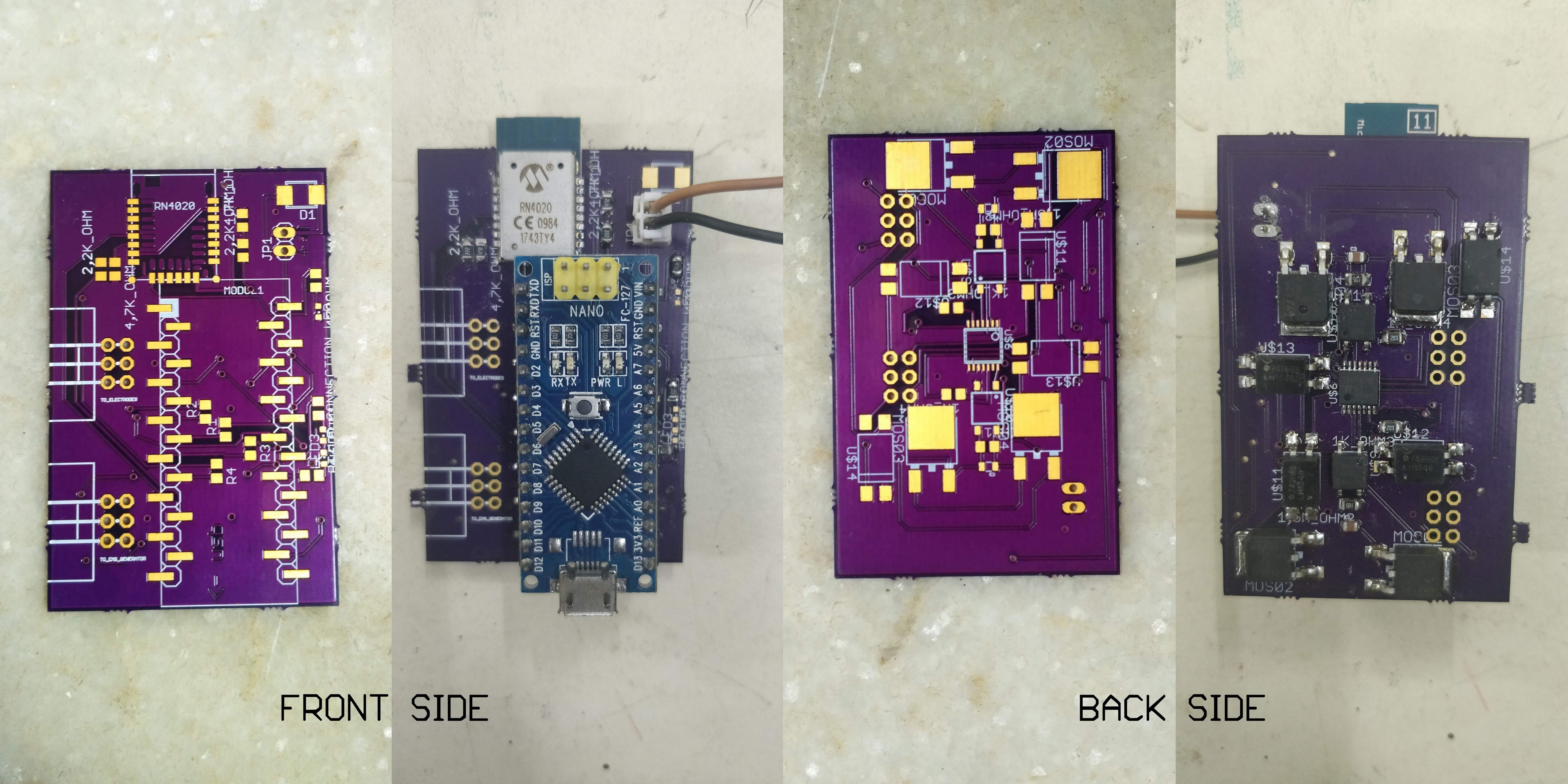
EMS modulation system - PCB's from OSHPark
The setup uses a Arduino Nano to provide switching for the relay, the AD5252 10 bit 2-channel Digital to Analog converter talks over i2c to the nano and provides analog input to the gate of the MOSFETS through the optoisolators. The system allows dual channel TENS interfacing and provides stimulation through electrodes. The setup also uses an RN4050 BLE module to allow remote control over phone. The setup is powered using a 9V battery and uses the Nano's internal voltage regulator to power all electronics. The setup gave us a firm grasp into what went on in the setup. This prompted us to start tweaking the setup to allow us to integrate with the rest of NeuroCuddl interface.
We first began by removing the AD5252 carefully soldering a wire to the SMD pinout of the optoisolator and using the Teensy's own 12 bit DAC (1-channel) to provide gate voltage to the MOSFET's. We then proceeded to power the whole unit using a 3.3V regulator and we then successfully got the unit working with the Teensy. We removed much of the original code and used Teensy's AnalogWrite and the DigitalWrite for the relay controls. The TENS unit we used, Ultima 3t is a FDA certified dual channel TENS with analog control.
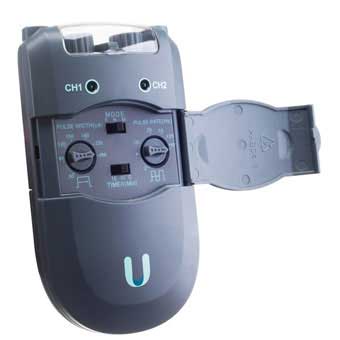
Here are some photos during our early experiments.
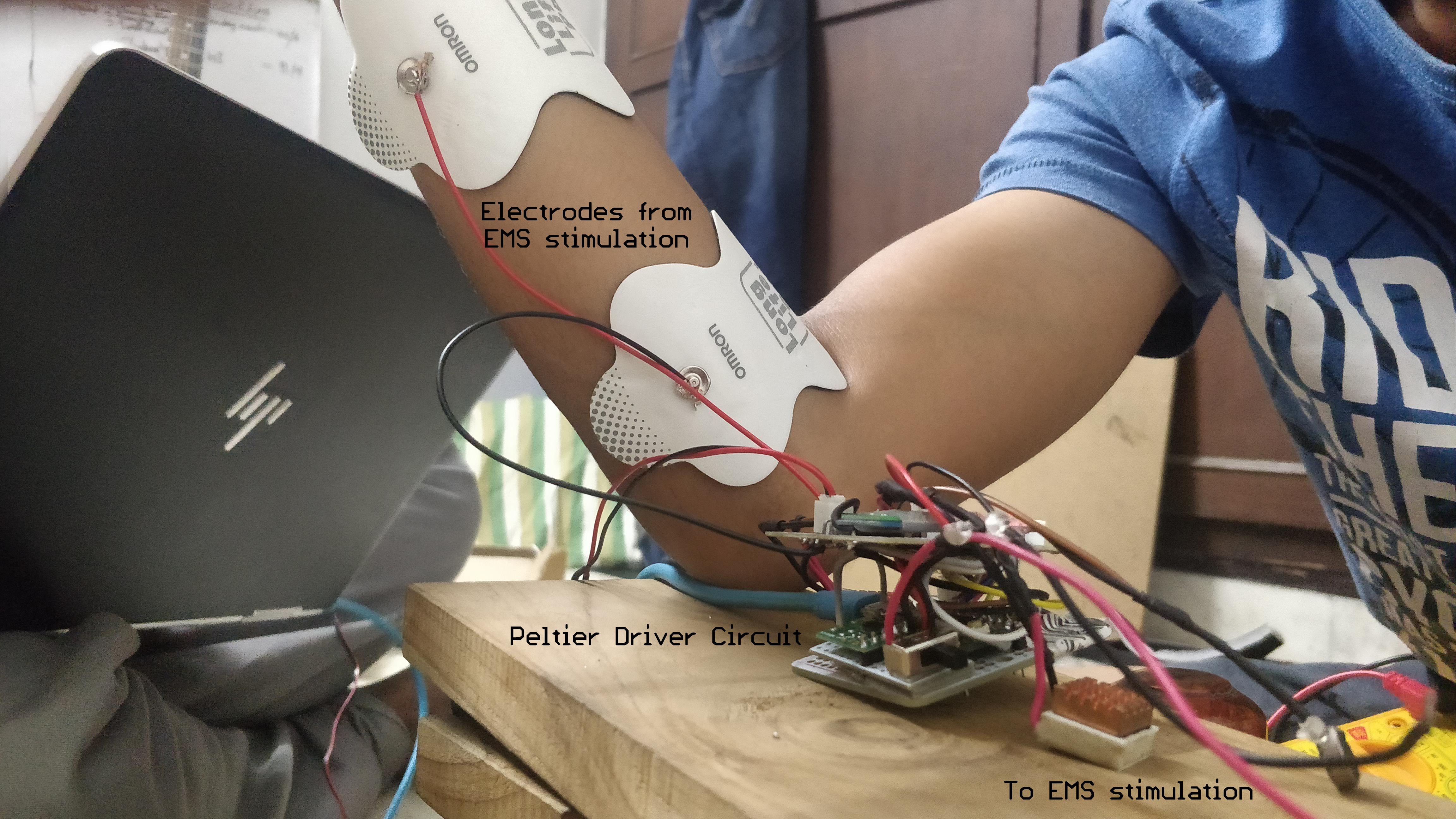
In conclusion, We found electrostimulation to be an excellent sensation for pain and stress relief and observed certain frequencies to have buzzing and relaxing effects. We further understood the carefully steps we would need to take to ensure safety of the user and we hope to incorporate features in our design to prevent users from accidentally configuring the TENS electrodes wrong. The next steps would be to integrate the TENS modulation system with our own system and ensure the safety standards are maintained.
In the next log we will look at the game in action and see what design decisions we had to make for design of the game.
 Vignesh Ravichandran
Vignesh Ravichandran
Discussions
Become a Hackaday.io Member
Create an account to leave a comment. Already have an account? Log In.